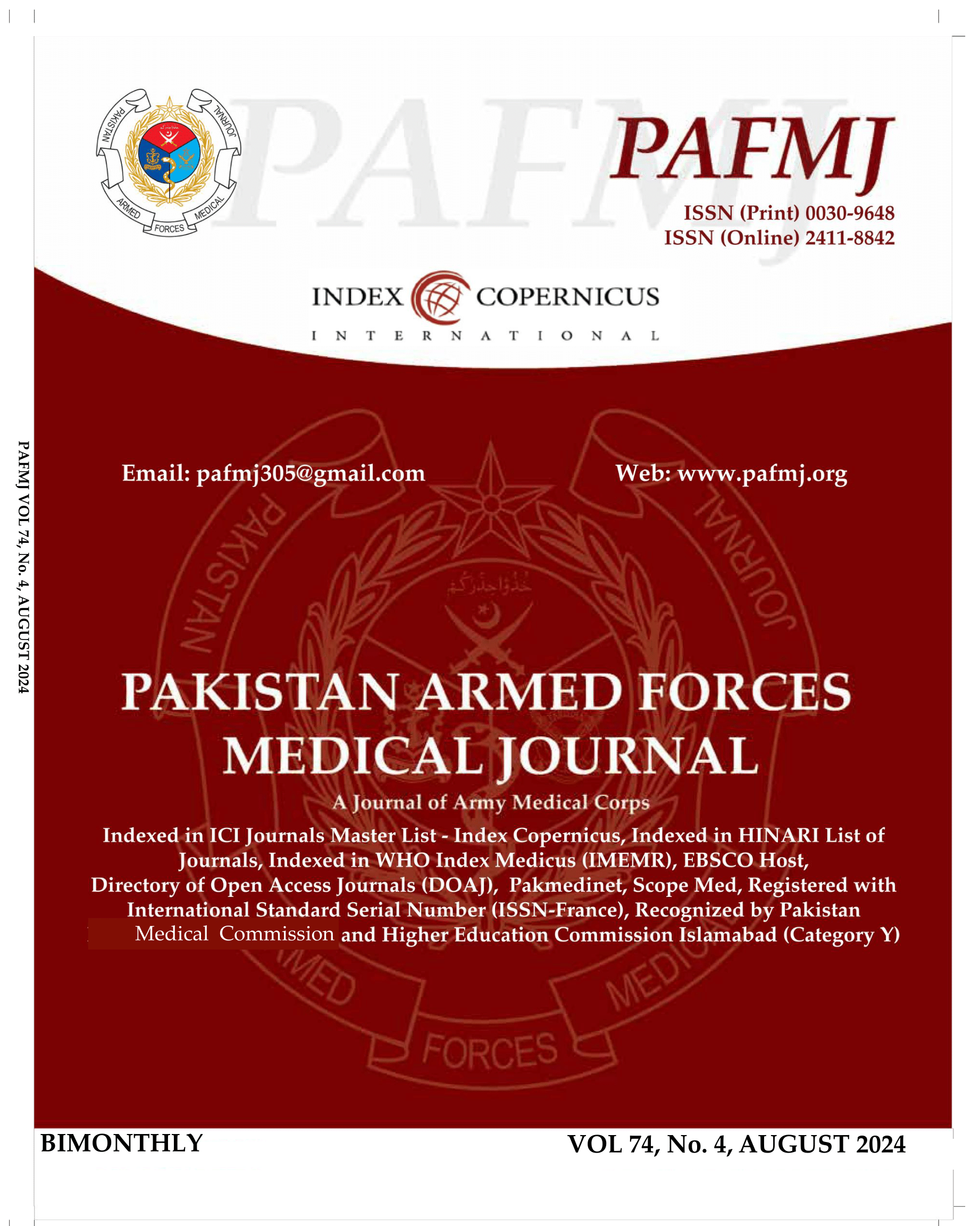Nasolabial Angle-A: Correlation Between Anatomic Point Tracing Method and Mean Tangential Lines Tracing Method
DOI:
https://doi.org/10.51253/pafmj.v74i4.9239Keywords:
Anatomy, Anatomic point tracing method, Nasolabial, Tangent line tracing methodAbstract
Objective: To determine the correlation between mean Nasolabial Angle between anatomic point tracing method and mean tangent lines tracing method.
Study Design: Cross-sectional study.
Place and Duration of Study: Military Dental Centre, Combined military Hospital, Malir Cantonment Karachi Pakistan, from Jan to Jun 2022.
Methodology: A total of 30 patients were included in the study. Acquired tracings were photocopied 4 times (out of these 4 tracings, 2 were used for tracing nasolabial angle by drawing anatomic landmarks method and other 2 were used for finding nasolabial angle through the tangential method). First two copies were used to trace cephalometric tracing to evaluate nasolabial angle by the same investigator using anatomic landmarks point method and tangential method after interval of 4 weeks for purpose of inspecting intra observer reproducibility.
Results: Patients ranged between fifteen to twenty-five years of age with mean age of 19.6±2.8 years. Out of these patients 19(63%) were males and 11(36.7%) were females. Value of mean anatomic point tracing method was 98.5±2.6 and tangent line tracing method was 90.3±5.0. Pearson correlation coefficient between mean nasolabial angle by both of these above-mentioned methods was r=0.381 with a significant p value (p=0.038).
Conclusion: After assessment of data obtained, it was established that there was a correlation between both methods of evaluating of nasolabial angle.
Downloads
References
Felemban OM, Alharabi NT, Alamoudi RA, Alturki GA, Helal NM. Factors influencing the desire for orthodontic treatment among patients and parents in Saudi Arabia: A cross-sectional study. J Orthod Sci 2022 4; 11: 25.
https://doi.org/10.4103/jos.jos_181_21
Mandrekar PN, Dhupar V, Akkara F. Prediction of Soft-Tissue Changes Following Single and Bi-Jaw Surgery: An Evaluative Study. Ann Maxillofac Surg 2021; 11(1): 32-36.
https://doi.org/10.4103/ams.ams_138_20
Denadai R, Chou Y, Su Y, Lo C, Lin H, Ho CT, et al. Facial Appearance and Psychosocial Features in Orthognathic Surgery: A FACE-Q- and 3D Facial Image-Based Comparative Study of Patient-, Clinician-, and Lay-Observer-Reported Outcomes. J Clin Med 2019; 8(6): 909.
https://doi.org/10.3390/jcm8060909
Jeon S, Lee KC. Comparison of cephalometric measurements between conventional and automatic cephalometric analysis using convolutional neural network. Prog Orthod 2021; 22(1): 1-8. https://doi.org/10.1186/s40510-021-00358-4
Van-Bunningen RH, Dijkstra PU, Dieters A, van der Meer WJ, Kuijpers-Jagtman AM, Ren Y. Precision of orthodontic
cephalometric measurements on ultra low dose-low dose CBCT reconstructed cephalograms. Clin Oral Investig 2022; 26(2): 1543-1550. https://doi.org/10.1007/s00784-021-04127-9
Derwich M, Minch L, Mitus-Kenig M, Zoltowska A, Pawlowska E. Personalized Orthodontics: From the Sagittal Position of Lower Incisors to the Facial Profile Esthetics. J Pers Med 2021; 11(8): 692.
Jung J, Lee CH, Lee JW, Choi BJ. Three dimensional evaluation of soft tissue after orthognathic surgery. Head Face Med 2018; 14(1): 21. https://doi.org/10.1186/s13005-018-0179-z
Saki M, Danaei SM, Sardarian A, Shavakhi M. Changes of nasolabial angle from rest to smile in relation to cephalometric parameters. Int J Esthet Dent 2019; 14(4): 434-442.
Hwang HS, Kim WS, McNamara JA Jr. A comparative study of two methods of quantifying the soft tissue profile. Angle Orthod 2000; 70(3): 200-207.
Giri J, Pokharel PR, Gyawali R, Bhattarai B, Shrestha GK. Comparison of Reproducibility of Nasolabial Angle Constructed by Anatomic point method and Tangent line method. Orthod. J Nepal 2017; 6(2): 10-23.
Storniolo-Souza JM, Seminario MP, Pinzan-Vercelino CRM, Pinzan A, Janson G. McNamara analysis cephalometric parameters in White-Brazilians, Japanese and Japanese-Brazilians with normal occlusion. Dental Press J Orthod 2021; 26(1): e2119133.
https://doi.org/10.1590/2177-6709.26.1.e2119133.oar
Sreenivasagan S, Sivakumar A. FSA Angle: A Soft Tissue Approach for Assessing Sagittal Skeletal Discrepancy. Int J Clin Pediatr Dent 2021; 14(Suppl 1): S54-S56.
https://doi.org/10.5005/Fjp-journals-10005-2017
Jin ZL. Effect of orthodontic treatment on facial soft tissue in female adult. Zhonghua Kou Qiang Yi Xue Za Zhi 2019; 54(12): 815-818.
https://doi.org/10.3760/cma.j.issn.1002-0098.2019.12.005
Choi SY, Kim SJ, Lee HY, Chang DS, Choi MS. Esthetic nasolabial angle according to the degree of upper lip protrusion in an Asian population. Am J Rhinol Allergy 2018; 32(1): 66-70. https://doi.org/10.2500/ajra.2018.32.4485
Quinzi V, Paskay LC, D’Andrea N, Albani A, Monaco A, Saccomanno A. Evaluation of the Nasolabial Angle in Orthodontic Diagnosis: A Systematic Review. App Sci 2021: 1-18.
https://doi.org/10.3390/app11062531
Feghali J, Khoury E, Souccar NM, Akl R, Ghoubril J. Evaluation of preferred lip position according to different tip rotations of the nose in class I young adult subjects. Int Orthod 2019; 17: 478-487.
https://doi.org/10.1016/j.ortho.2019.06.024
Harris R, Nagarkar P, Amirlak B. Varied Definitions of Nasolabial Angle: Searching for Consensus Among Rhinoplasty Surgeons and an Algorithm for Selecting the Ideal Method. Plast Reconstr Surg Glob Open 2016; 4(6): e752.
https://doi.org/10.1097/GOX.0000000000000729
AlMansoub Y, Jubari M, Li A, Jun L, Tang S. Patient’s facial soft tissue changes following the orthodontics treatment. IOSR J Dent Med Sci 2019; 18: 69–78.
Durão AP, Bolstad NL, Pittayapat P, Lambrichts I, Ferreira AP, Jacobs R. Accuracy and reliability of 2D cephalometric analysis in orthodontics. Rev. Port. Estomatol. Med. Dent. Cir. Maxilofac 2014. 135-141. https://doi.org/10.1016/j.rpemd.2014.05.003
Kandhasamy K, Prabu NM, Sivanmalai S, Prabu PS, Philip A, Chiramel JC. Evaluation of the nasolabial angle of the Komarapalayam population. J Pharm Bioallied Sci 2012; 4(Suppl 2): S313-315. https://doi.org/10.4103/0975-7406.100284
İzgi E, Pekiner FN. Comparative Evaluation of Conventional and OnyxCeph™ Dental Software Measurements on Cephalometric Radiography. Turk J Orthod 2019; 32(2): 87-95.
https://doi.org/10.5152/TurkJOrthod.2019.18038
Scheideman GB, Bell WH, Legan HL, Finn RA, Reisch JS. Cephalometric analysis of dentofacial normals. Am J Orthod 1980; 78: 404-420.
Kishore S, Dinesh, S, Srirengalakshmi, Sivakumar, A. Comparing the accuracy of Manual Tracing to Digital Tracing – Angular Measurements. Int J Pharm Sci Res 2019; 10: 1302-1306
Downloads
Published
Issue
Section
License
Copyright (c) 2024 Kashif Iqbal, Taimoor Safdar Chaudry, Ali Akhtar Khan, Abdullah Jan, Javed Iqbal Bangish, Khurram Waheed

This work is licensed under a Creative Commons Attribution-NonCommercial 4.0 International License.















